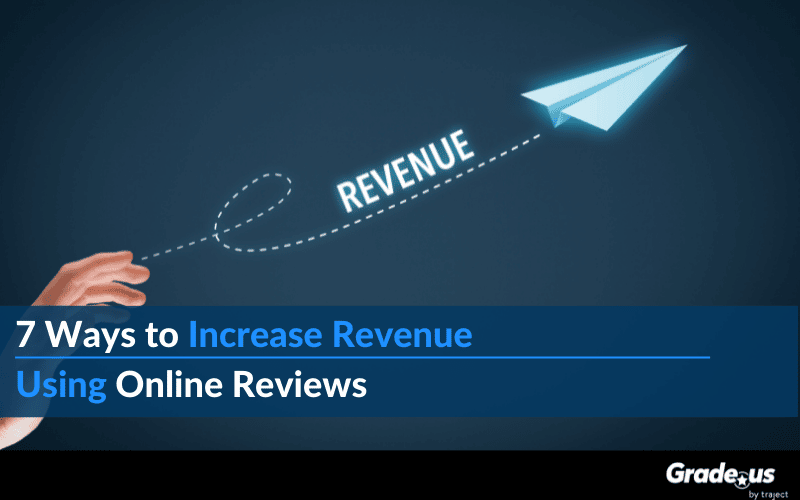Reviews generate revenue.
That’s the story, right? We know negative reviews can destroy a business, but what about the opposite end of things?
Can reviews really generate revenue for your business?
Or is it the kind of thing where marketers say that then they use analytics to justify their claim afterward? As you’ll soon see, there are simple strategies and tactics that, when used well, produce cash flow for your business.
Why your reviews should produce revenue
What does your business need?
This sounds like an obvious question, and it is. But it’s not so obvious when it’s time to connect these obvious needs to your reviews. Let’s take a look at the things businesses need first; then, we’ll take a look at how online reviews can contribute to these needs.
- Traffic: A steady supply of prospects from a variety of sales channels.
- Customers: These are buyers who are willing and able to buy your products and services.
- Cash flow: The revenue coming in to (and out of) your company.
- Profit: The revenue left after expenses, taxes, insurance, etc.
- Growth: An increase in top-line or bottom-line growth over a set period (e.g., year-over-year).
Obvious, right?
If you’re in business, you already know you need this. What you may not know is how online reviews can increase growth in each of these five categories.
So let’s break it down.
Online reviews increase…
- Traffic by increasing website traffic from Google Search (via local packs, knowledge panels, and search results), Google Maps, Google Seller Ratings, etc.
- Inbound customers by matching organic and paid keyword queries to searcher intent
- Cash flow by boosting conversion rates for opt-ins, follows, likes, subscriptions, and purchases. The money is in the list, and reviews are a helpful conversion aid that boosts revenue.
- Profit by decreasing your cost per lead and increasing your revenue per customer by reducing buyer resistance and friction.
- Growth by increasing your average order values by using upsells, cross-sells, and down-sells to increase repeat orders.
As you probably already know, these five goals, traffic, customers, cash flow, profit, and growth, are the keys to long-term survival. Now let’s take a look at how you can put your reviews to work in each of these five categories.
Step #1: Add reviews to your decision pages in your checkout
What does the data say?
Research shows that brands that move their Google My Business profile’s rating from a 3.5 to 3.7 stars experience conversion growth of 120%.
But wait, there’s more!
Northwestern University’s Spiegel Research Center analyzed 57,000 reviews from anonymous consumers and 65,000 reviews from verified buyers of more than 13,500 unique products in diverse categories. Their findings mentioned reviews could increase conversion rates by 270%.
There are lots of studies about this.
Reviews generate revenue.
Here’s the problem; the vast majority of brands use reviews passively.
- They occasionally request reviews from customers
- Customers write a review on a review site (e.g., Yelp, TripAdvisor, Google, etc.)
- The reviews are picked up by Google and shared via Google Search and Google Maps.
Then these reviews are forgotten.
A better approach would be to use these reviews as point-of-decision prompts (posted or embedded) on your decision pages.
Here are a few examples.
- Post reviews on your sales pages
- Post reviews on your checkout or payment confirmation pages
- Add a low-priced product + reviews to your opt-in confirmation pages
- Post reviews as a background to shipping confirmation pages
- Share reviews on your order fulfillment pages to minimize buyer’s remorse
- Post a review carousel on your request, contact, or support request pages
- Promote reviews in your proposal or quote pages
- Share audio versions of your reviews as your on-hold music
- Share reviews via intelligent modal pop-ups and catfish ads
The sky’s the limit here.
Sharing reviews on each of your point-of-decision pages minimizes buyer’s remorse and maximizes conversion rates. It’s an easy way to attract, convert, and retain customers, extending the life of each review indefinitely.
Step #2: Promote your ads to cold, warm, and hot traffic
Perry Marshall promotes an important budgeting concept in advertising. It’s designed to maximize the results you receive from your ad spend.
He calls it 60/30/10.
- 10% of your budget on Cold traffic. These prospects don’t know you; they’re not familiar with you, and they’re not all that eager to work with you.
- 30% of your budget on Warm traffic. These prospects have heard of you. They’ve expressed some interest in your product or service (e.g., an opt-in, they’ve clicked through, etc.). They’re slightly more warm and interested in your product or service.
- 60% of your budget on Hot traffic. These customers are actively considering your product or service. Either they’re interested in your product or service, or they’re already customers.
Where do reviews fit in?
Create a remarketing/retargeting campaign to sell to your hot traffic. First, create a list of objections; these could be objections about price, timing, results, etc. Next, find reviews in your review portfolio that address this objection directly. Here’s a detailed breakdown if you’re not sure how to do it.
Finally, create ads that showcase these specific reviews.
Link these ads to the specific reviews in your review portfolio. You’ll want to direct prospects to a third-party review site like Yelp, TripAdvisor, Google Reviews, etc. These ads shouldn’t send people to your site.
Step #3: Combine case studies + reviews to boost conversion rates
Let’s say you have a service business.
You want to attract more clients to your business, so you decide to write up a case study. If you’re like most businesses, you write a case study that documents the results and outcomes you’ve achieved for your clients.
Just one problem.
These case studies aren’t as compelling as they should be. That’s because they’re missing your client’s perspective. So how do you change this? It’s simple, you create case studies that include your client’s perspective.
Here’s how you do it.
- Get your client’s feedback.
- Outline your client’s goals, objections, and key metrics at the start of the campaign.
- Discuss the problems and barriers preventing your clients from achieving the results they want.
- Document the solution and your approach to their problem.
- Share the results you achieved for your clients.
Steps two through five are pretty self-explanatory, but what about step one?
How do you get client feedback?
Easy, you ask.
You get your client’s permission, then you schedule a 5 or 10 min. phone call. Ask your client’s the right questions and record their answers. This is important because questions give your clients a track to follow. It’s easy to remember your experience when you’re being asked about the specifics.
Here are some questions you can ask.
- Did we make you happy?
- What would have prevented you from purchasing [service]?
- What did you find as a result of purchasing [service]?
- What did you like most about [service]?
- What would be three other benefits to this product (or service)?
- Would you recommend [company] to someone else? Why?
Can you see what’s happening?
When customers answer these questions, they automatically give you a believable and credible review that defuses prospective client objections.
What happens after that?
You take the feedback you’ve received from clients and weave it into your case study. Be sure to include the client or company name, the name and title of your point of contact, and the specifics of their situation.
Then what?
You publish your case study on your website, then you send the transcribed feedback to your client, along with a link to the review site of your choice. Ask them to copy and paste the feedback you’ve transcribed for your case study into the review site (i.e., Google Reviews, Yelp, Avvo, etc.) in your email.
This is doable for most service businesses.
You’re not dealing with the massive sales volume Amazon deals with. You’re working with clients on a one-on-one basis.
Step #4: Respond to reviews within 24 hrs after they come in
A response isn’t common; 75% of businesses don’t respond to any of their reviews. Is it worth it to respond to your online reviews? Well, let’s look at the data.
- Businesses that don’t reply to any reviews earn 9% less revenue than average
- Businesses that reply to their reviews at least 25% of the time average 35% more revenue
- A 30% reply rate is the benchmark for conversion growth to outstrip your competitors. When enterprise locations increased their reply rate for Google reviews from 12% to 32% of reviews, they achieved 80% higher conversion rates in local search than direct competitors.
- People spend up to 49% more money at businesses that reply to reviews
- Review volume increased by 12%, and ratings increased by an average of 0.12 stars just because the brand started responding to reviews.
- 89% of consumers read local businesses’ responses to reviews
This is obvious, right?
Simply create systems and procedures that allow you to respond to customers within 24 hours. Make this a consistent habit, and you’ll find it’s easier to generate reviews, surpass competitors, and earn more revenue.
Step #6: Get negative reviews, fix the issue, then respond to negative reviews
You need bad reviews.
Research shows that 82% of customers seek out negative reviews.
- Research from Womply shows that businesses whose total number of reviews are 15-20% negative average 13% more annual revenue than businesses whose reviews are 5-10% negative.
- Revoo found that time on site is 5x longer when customers interact with negative reviews, producing an 85% increase in conversion.
- Negative reviews establish credibility. Readers are skeptical of reviews that are too positive, and, in many cases, a negative online review is seen as more credible.
Your customer’s default is distrust. As a general rule, your customers have two mindsets. Optimism or pessimism. Optimists are easy to sell to but harder to keep. Pessimists, on the other hand, are harder to sell to but easier to keep.
How are you supposed to get the benefits of negative reviews while avoiding the significant downsides? Start by focusing on the right ratio of positive and negative reviews.
Stick with an ideal ratio of 5 to 1.
At least five positive reviews for every one negative review. What happens when you get a negative review? You reach out to customers and ask them about their experience.
Then you fix the problem.
Afterward, you return to customers and ask them if you’ve fixed the problem to their satisfaction. If you have, ask them about their experience using the questions from step three. If they’re open to it, see if they’re willing to update their review.
Step #7: Create a research report based on aggregate review data across the industry
Are you in the top 10% of your industry?
If you’re using review management tools like Grade.us, you can compile a list of trends and the general sentiment of customers in the industry. You can use this report to teach customers what to look for, outlining the important must-haves as well as the red flags and issues to avoid.
Your report can include:
- Rankings: A concise breakdown of the companies in your industry, including specialties, size, and focus areas
- Authority: How is each company perceived (by its peers) across the industry?
- Specialties: The focus areas of each company and the details that make them unique
- Reviews: How do customers feel about the companies in your report? What’s their reputation throughout the industry?
- Pricing: A list of the various price ranges and pricing models (e.g., retainer vs. flat fee, subscription, recurring, or one-time billing)
What happens when you finish this report?
You share it with customers via your website. What if your competitors are unhappy with your report? Well, there’s an easy fix for this. Bring them on as collaborators; let them know you’d like their help creating this report. Show them that you’d like the report to be fair, and let them know that it’s free advertising (for you and them).
What if they refuse to collaborate with you?
No problem.
Make a list of the companies that refused to collaborate with you. Share the report with those who decided to pass. This gives them a clear idea of your approach for next time, and it shows them that you’ll be fair. It’s an easy way to build strong relationships with competitors and customers.
When the report is ready, include your information and promote it via paid search and display advertising.
Your online reviews should produce revenue
If you’re in business, you have five goals you need to achieve: traffic, customers, cash flow, profit, and growth – these are the keys to long-term survival. Put your reviews to work in each of these five categories, you’ll extend the life of each review indefinitely, and you’ll maximize performance in each category.
The vast majority of brands use reviews passively. They occasionally request customer reviews, which are forgotten over time.
Make your reviews stronger.
Put your reviews to work, and you’ll find it’s easier and cheaper for your business to achieve the gains it needs to grow year-over-year. A systematic process that ensures your progress is up and to the right.









